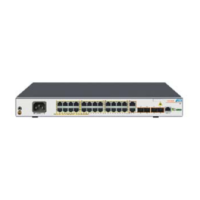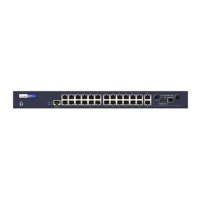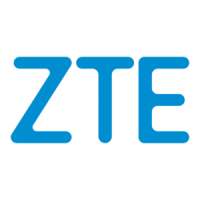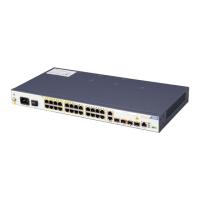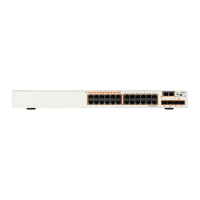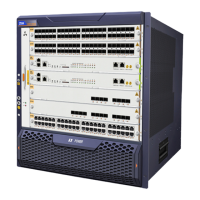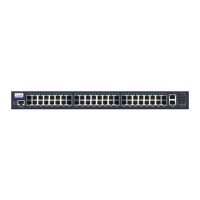
Do you have a question about the Zte ZXR10 2900 Series and is the answer not in the manual?
| VLANs | 4K |
|---|---|
| Operating Temperature | 0°C to 45°C |
| Storage Temperature | -40°C to 70°C |
| Category | Switch |
| Ports | 10/100/1000Base-T Ethernet ports |
| Switching Capacity | 128 Gbps |
| MAC Address Table | 16K |
| Jumbo Frame | 9K |
| Operating Humidity | 10% to 90% RH |
| Storage Humidity | 5% to 95% RH |
| Power Supply | AC or DC |
Provides guidelines for safe installation, operation, and maintenance of the devices.
Explains the meaning of warning, caution, and note formats used in the manual.
Introduces the ZXR10 series intelligent access Ethernet switch and its models.
Details the wire-speed layer-2 switching capabilities and high throughput.
Explains redundancy backup, fast switching, and ring network support for high availability.
Describes flexible VLAN classification, VPN, user port location, and L2 multicast technologies.
Outlines user, equipment, and network security features including 802.1x and ACLs.
Details QoS features like packet classification, queue scheduling, and Committed Access Rate.
Lists supported management methods including SNMP, CLI, and Web access.
Provides a comprehensive list of switch functions, including port features and protocols.
Presents detailed technical specifications like size, weight, power, and performance metrics.
Explains the product's modular structure: control, switch, interface, and power modules.
Details the box structure, chassis, front/back panels, and cooling methods.
Describes available sub-boards (FGEI, FGFI, FGFE, FBFE) and their specifications.
Details the power supply options supporting -48V DC and 110V/220V AC power.
Covers installation on a desk or in a 19-inch cabinet, including mounting procedures.
Explains the connection types: power, console, network cables, and optical fibers.
Provides guidelines for lightning protection to reduce equipment failure rates.
Details the process of connection configuration using HyperTerminal for debugging.
Introduces various methods for configuring the switch: Console, Telnet, SSH, SNMP, WEB.
Explains the different command modes (User, Global Config, etc.) for switch management.
Covers online help, command abbreviations, history commands, and functional keys.
Details operations for managing the FLASH memory, including file system introduction and operations.
Explains how to back up and restore switch configuration files using TFTP.
Covers importing and exporting configuration information for easy management.
Describes how to back up and recover configuration and version files.
Provides procedures for upgrading software versions, including normal and abnormal system states.
Details commands for configuring port parameters like basic settings, QoS, and 802.1X.
Explains MAC filter, static address binding, and MAC table aging time configurations.
Covers configuring ingress and egress mirroring for traffic monitoring.
Describes how to enable and configure single port loop detection to prevent network loops.
Details VLAN concepts and basic configurations like creating, adding/deleting ports, and trunks.
Explains GARP and GVRP protocols for dynamic VLAN and MAC address distribution.
Covers Private VLAN configuration, including promiscuous and isolated ports.
Explains QinQ technology for VLAN stacking, enabling Layer 2 VPNs.
Details Selective QinQ for selective outer tag addition based on inner tags.
Covers Link Aggregation Control Protocol (LACP) for bundling links into a logical one.
Explains Spanning Tree Protocol (STP), RSTP, and MSTP for loop prevention.
Details ZTE Ethernet Smart Ring (ZESR) protocol for network reliability and fault convergence.
Explains IGMP Snooping to efficiently manage multicast traffic and reduce bandwidth waste.
Covers configuration for Internet Protocol television (IPTV) services.
Details configuration for the switch as a DHCP client to obtain dynamic IP addresses.
Explains DHCP snooping and Option82 for network safety and IP address assignment.
Covers Virtual Broadband Access Server (VBAS) for wide-band user identifier solutions.
Describes EPON technology for passive optical networks and its functions on ZXR10 series.
Details Access Control Lists (ACLs) for packet filtering and security policy implementation.
Explains Quality of Service (QoS) functions for priority control and traffic management.
Covers transparent transmission of Layer 2 protocols like STP, LACP, and 802.1x.
Details Layer 3 functions for remote configuration and management, including static routes.
Explains Network Access Service (NAS) for subscriber authentication and management.
Covers Syslog for managing system information, filtering logs, and diagnosing faults.
Details Network Time Protocol (NTP) for synchronizing device clocks.
Explains Operation, Administration, and Maintenance (OAM) protocols for link management.
Covers restrictive mechanisms for secure network management login via Telnet, SSH, SNMP, WEB.
Details Secure Shell (SSH) for secure remote access, encrypting data transmission.
Explains Simple Network Management Protocol (SNMP) for network device monitoring and control.
Covers Remote Monitoring (RMON) for network traffic analysis and behavior monitoring.
Details ZTE Group Manage Protocol (ZGMP) for managing a set of switches as a unified domain.
Explains SFLOW for monitoring high-speed data transmission networks using sampled packets.
Covers managing the switch remotely via a standard Web browser.
Provides access to the terminal log information page for viewing system messages.
Displays port statistics including received/sent bytes, frames, and errors.
Shows the current configuration information of the switch.
Explains how to save the current configuration to the FLASH memory.
Provides instructions for rebooting the switch.
Details the process of uploading files like firmware or configuration to the switch.
Covers managing user accounts, including adding and deleting users.
